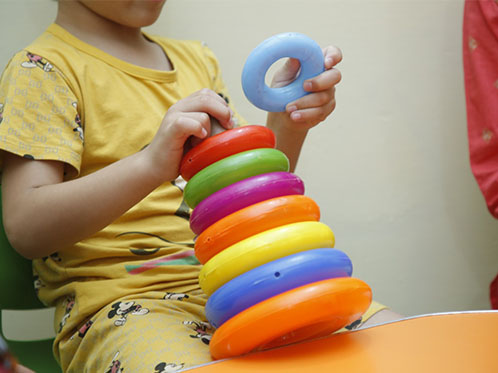Repetitive Behaviors in Autism
The term “repetitive behaviors” refers to irregular behaviors marked by repetition, rigidity, inadequacy and failure of ability to adapt. Other types of repetitive behaviors involve obsessions, fixations, or worries about things, such as fixating on a part of an object (constantly spinning the wheels on a toy car or lining up objects). Stress, fear, and anxiety are some of the factors often attributed to the triggers of repetitive behaviors. Repetitive, purposeless actions are a common symptom of autism. Repetitive habits can potentially be harmful in extreme cases; more often, however, they are a tool for self-calming. In reality, many parents worry about autism when they see their child constantly lining up toys, spinning items, or opening and closing drawers or doors. When they get in the way of everyday tasks or make it difficult to get through school or work, they can become a concern.
“Stereotyped” Behaviors and Autism
Seemingly purposeless, repetitive and obsessive behaviors and highly selective, and rigid interests are identified as signs of Autism. Researchers often term these behaviors as “stereotypy” or “perseveration.” In other neurological disorders, various forms of stereotypy and perseverance are present as well. Restricted, repeated patterns of behavior, or desires, as reflected by at least two of the following can help identify Autism
- Motor movements that are stereotyped or repetitive. This can include object use or voice. Simple motor stereotypes, lining up toys, tossing items, echoes, idiosyncratic phrases are examples
- Insistence on sameness, adherence to habits inflexibly, or Ritualised patterns of verbal or Nonverbal behavior. Examples include intense discomfort at minor changes, adjustment challenges, Static habits of thought, Rituals of greeting, the need for the same route or food every day.
- Highly restricted, fixed interests which are irregular in strength or concentration. Strong attachment to or concern for odd objects, overly circumscribed or persevering interests are examples.
What Stereotyped Behaviors Look Like
Repetitive behaviors in autism can vary radically from person to person. For some, it involves saying or talking about the same things over and over again.
This can include things like listing all of Marvel’s Avengers and their powers, reciting scripts from TV, or asking the same question many times in a row). For some, it involves physical acts like rolling, swiping, or moving repetitively. Stereotyped actions may be aggressive in more extreme autism, including head-banging. Some individuals on the autism spectrum constantly engage in repetitive behaviors, while others persevere occasionally, when stressed, anxious, or upset. While changes can be irritating for someone who is not autistic, for individuals with Autism, it can be a cause of extreme anxiety. For example, when an individual with autism is asked to alter a routine, the response may be excessive anxiety or frustration, even if the individual is very high functioning.
Sometimes, though, to the casual observer, autistic repetitive behaviors may not be evident. For example, a child with autism may ask “Do you like Marvel movies?” If you say “yes,” they might run through the same Iron Man speech they’ve been through 10 folds previously, in similar words, with exactly the same tone and expressions. You may know the speech backward and forward as a parent or close friend, but as a new friend, you do not know they have said it before.
Are Repetitive Behaviors a Problem or Not?
These types of behaviors aren’t unique to people with autism. Most people engage in similar behaviors. Common forms of perseveration include:
- Nail biting
- Pacing
- Pencil or toe-tapping
- Compulsive cleaning
- A “need” to watch the same TV shows or sporting events without fail
The problem of perseverance is actually not a problem for people with autism, because it only happens when they are under stress, and such behaviors make it easy for them to navigate difficult situations (as with most neurotypical people).
For people with autism, perseverance may also be a bonus, as it can contribute to a passionate interest that can lead to friendships or even professions. For example, someone with a constant interest in video games will enter gaming clubs and meet others with a similar passion.
However, for many individuals with autism, perseverance or repetitive behavior is not only alarming, but it is also a significant barrier to worldwide contact and involvement. An individual who flicks his hands compulsively to the exclusion of all else is less likely to be able to attend or take part in social events.
Treatment and Causes
Though there are a number of theories, there’s not much evidence to help us understand what causes perseverance in people with Autism. The theory you embrace can cause you to choose a specific treatment (or no treatment at all). If a repetitive behavior is dangerous or risky, of course, it must be modified. Certain therapies have been more thoroughly studied than others, with varying degrees of success. If you believe that repetitive activities are a way for children with Autism to self-calm, block too much sensory feedback, then you are likely to use strategies of sensory integration to help the individual relax themself and regain a sense of control. If the perseverance is a representation of real desires, you are likely to use motivational strategies such as ‘Floor time’ or ‘Son Rise’ to interact with them and help them turn perseverance into productive activities. If you assume that perseverance is induced by anxiety or a chemical or neurological problem, you can try to regulate such actions by using medication.
An Informative Word
A child’s repetitive behaviors can make their parents conscious about how society may perceive them. Some families isolate themselves from the social gatherings (like family events, wedding celebrations, going to the mall). because many people lack awareness regarding repetitive behaviors and Autism. So it is important for parents to consider the role repetitive behaviors serve in their children’s life before taking measures to “extinguish” them. Parents may need to assist their child while they adjust or build on the routines that help them remain relaxed, overcome sensory issues, or otherwise handle the requirements of everyday life.
This can involve having a therapist to work with your child to help them relax in other ways, or changing the environment your child based in their needs.



